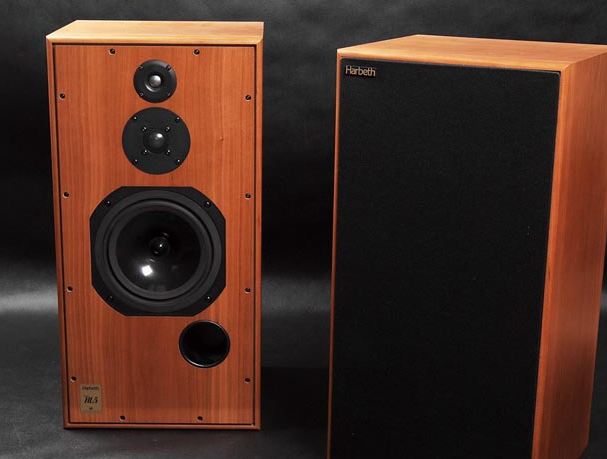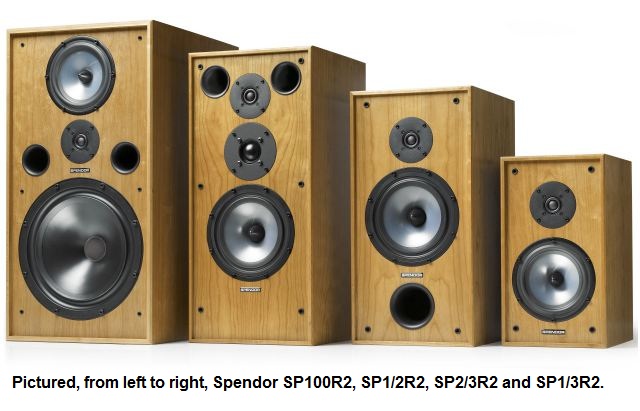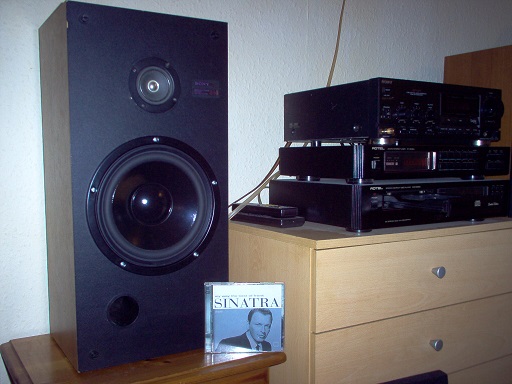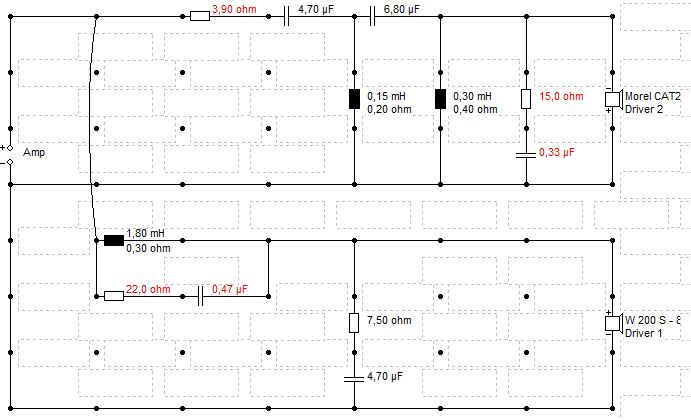They were all the rage a few decades ago, and a few still sold, but I was wondering looking at the need to move to a 1 1/8 tweeter to get the crossover low enough for a 6 inch mid/bass, but top end issues and excessive stored energy make it a less than an optimal option. What are the drawbacks from the larger tweeter, and then slap something with a great top end, even a little XT-25G on it for 10K up? First order crossover even.
I would rather a really great midrange that could get up to 4K where you could use one of several decent 3/4 tweeters, but they seem to be in short supply or their efficiency is so low, you would have to bi-amp.
I would rather a really great midrange that could get up to 4K where you could use one of several decent 3/4 tweeters, but they seem to be in short supply or their efficiency is so low, you would have to bi-amp.
Since we are in the FR domain, the issue of restoring a smooth high-end of our full-range drivers is predominant. The issue of crossing over to a mid-bass strikes me as more a multi-way than that of a full-ranger.
Phase shifting & a loss of a point-source I would think is the issue with adding a super-tweeter to our elegant full-rangers.
--------------------------------------------------------------------------Rick...........
Phase shifting & a loss of a point-source I would think is the issue with adding a super-tweeter to our elegant full-rangers.
--------------------------------------------------------------------------Rick...........
IMO phase, spl, crossover and tweeter materials make 10k plus a source for fatigue. I not only stay away from ‘super tweeters’ but also metal domes. If you need something over the top of your full range consider an AMT
Wrong forum sorry, but your comments are valid.
Might I suggest Indigent, that if you find metal domes and over 10K fatiguing, it is because you have not lived with good ones or ones well implemented. I too stood by paper cones and silk tweeters until I learned how to implement them better. Too many try for a flat response in the top octave which is terribly fatiguing and not handling breakup IMD artifacts, even worse. Many tweeters should not be used on-axis. People miss-use drivers all the time. Can't tell you how many times I have seen XT-25's crossed @ 2K. (Hint: 3500 at a minimum or distortion is terrible) I also find folks afraid of using that little knob we used to have on our preamps. Tone control. Roll those puppies off! And come of those super tweeters were horrid piezo jobs so I can see where your view comes from on that and if sitting on top of the box, a foot away from the main driver. which makes phase/dispersion a nightmare. I was thinking of trimmed flanges and as close as possible.
My experience, is with proper crossover design, point source or more precisely sharply defined location across the soundstage, to be more of a near boundary reflection issue rather than the speaker. First time I got it right and heard a voice from "outside the room" accurately it blew my mind. Simple 2-way with mid-range drivers. It took a lot of work on the room and many tries on the crossover. Modified driver flanges got my drivers almost 2 inches closer.
I have only heard AMT's and ribbons used for a broader range. Maybe that is why I dislike them. Could be if crossed high enough, they are better. On top of a full range. Hmmmm
I do run a pair of full range on my desk. I gave up and had to add tweeters. First order 6K I think.
I watch this forum as I keep looking for what many call a full range, but I call a wide range driver that can reach well into 3 or 4 K cleanly and be efficient enough to work with the better higher excursion mid-bass and woofers. Bought some Mark, Fountek and Fostek but was not happy with any of them. Pushing the crossover out of the 2 to 4 K range seems attractive, just have not pulled it off. Most drivers sold as mid-range are very low efficiency making integration difficult. Or if smaller, they try to make them reach too low to advertise how "full range" the are instead of using them for their best attributes.
If there are better "full" or as I call "wide" range drivers from other than the brands I mentioned, clue me in. Always looking.
Might I suggest Indigent, that if you find metal domes and over 10K fatiguing, it is because you have not lived with good ones or ones well implemented. I too stood by paper cones and silk tweeters until I learned how to implement them better. Too many try for a flat response in the top octave which is terribly fatiguing and not handling breakup IMD artifacts, even worse. Many tweeters should not be used on-axis. People miss-use drivers all the time. Can't tell you how many times I have seen XT-25's crossed @ 2K. (Hint: 3500 at a minimum or distortion is terrible) I also find folks afraid of using that little knob we used to have on our preamps. Tone control. Roll those puppies off! And come of those super tweeters were horrid piezo jobs so I can see where your view comes from on that and if sitting on top of the box, a foot away from the main driver. which makes phase/dispersion a nightmare. I was thinking of trimmed flanges and as close as possible.
My experience, is with proper crossover design, point source or more precisely sharply defined location across the soundstage, to be more of a near boundary reflection issue rather than the speaker. First time I got it right and heard a voice from "outside the room" accurately it blew my mind. Simple 2-way with mid-range drivers. It took a lot of work on the room and many tries on the crossover. Modified driver flanges got my drivers almost 2 inches closer.
I have only heard AMT's and ribbons used for a broader range. Maybe that is why I dislike them. Could be if crossed high enough, they are better. On top of a full range. Hmmmm
I do run a pair of full range on my desk. I gave up and had to add tweeters. First order 6K I think.
I watch this forum as I keep looking for what many call a full range, but I call a wide range driver that can reach well into 3 or 4 K cleanly and be efficient enough to work with the better higher excursion mid-bass and woofers. Bought some Mark, Fountek and Fostek but was not happy with any of them. Pushing the crossover out of the 2 to 4 K range seems attractive, just have not pulled it off. Most drivers sold as mid-range are very low efficiency making integration difficult. Or if smaller, they try to make them reach too low to advertise how "full range" the are instead of using them for their best attributes.
If there are better "full" or as I call "wide" range drivers from other than the brands I mentioned, clue me in. Always looking.
Most adults don't really hear above 15kHz anyway, But if you think you miss something you can do that. You will probally create combing issues as you can't put the tweeters close enough to each other physically to avoid that. But as speaker building is always a matter of compromises...
And i would look for something with a better of axis response than the XT25, it's off axis response up high is terrible. Even something cheap like a small Dayton ND13FA-4 will do better.
And i would look for something with a better of axis response than the XT25, it's off axis response up high is terrible. Even something cheap like a small Dayton ND13FA-4 will do better.
Yes, the Vifa is very narrow beam, but quality way above it's price if used well.
My hearing still goes above 18. (I was testing some tweeters this week) When I was young, I had super hearing above 22K. I have been careful so I still have some left. My wife is still a super hearer and hyper sensitive to distortion in the upper octaves. This is my last big upgrade as by the time it gets old, all I'll need is a old Sony table radio for the nursing home. I have one to rebuild actually.
My hearing still goes above 18. (I was testing some tweeters this week) When I was young, I had super hearing above 22K. I have been careful so I still have some left. My wife is still a super hearer and hyper sensitive to distortion in the upper octaves. This is my last big upgrade as by the time it gets old, all I'll need is a old Sony table radio for the nursing home. I have one to rebuild actually.
Just a quick FWIW that while single-cap "crossovers" for super-tweeters are often used, I still think proper crossover methodology should be used.
For example, a ribbon with a first-order crossover at 10kHz (-3dB) will be receiving considerable power into the kHz range. Since ribbons don't do well with signals towards the bottom of their passband, I'd still aim to use relatively steep crossovers.
There's no point in designing a full-range speaker with low harmonic distortion, good polars, etc etc etc to then have a super-tweeter come along and undo all that work.
Chris
For example, a ribbon with a first-order crossover at 10kHz (-3dB) will be receiving considerable power into the kHz range. Since ribbons don't do well with signals towards the bottom of their passband, I'd still aim to use relatively steep crossovers.
There's no point in designing a full-range speaker with low harmonic distortion, good polars, etc etc etc to then have a super-tweeter come along and undo all that work.
Chris
First-order crossovers should be used with caution - excursion doubles for every octave below crossover frequency, until resonance is reached.
And i would look for something with a better of axis response than the XT25, it's off axis response up high is terrible. Even something cheap like a small Dayton ND13FA-4 will do better.
yes, i can not think of any use for a super tweeter (go beyond 40khz), it sounds more like there is some lack of high frequency dispersion, so maybe a robust ribbon tweeter should suit better then the xt25, or get another pair of xt25 and arrange them for better coverage?
I do want to have a go at this sort of supertweetery! Easier than a genuine 3 way on woodwork. 😀

6moons audio reviews: Harbeth Super HL5
Serious crossover effort, but little 3/4" tweeters do have a great high end. These must be SEAS tweeters.
I think a 6" polycone, a robust SEAS 1" and a more fragile SEAS 3/4" might do the business. My current wheeze is that ferrofluid is a bad thing.

6moons audio reviews: Harbeth Super HL5
Serious crossover effort, but little 3/4" tweeters do have a great high end. These must be SEAS tweeters.
I think a 6" polycone, a robust SEAS 1" and a more fragile SEAS 3/4" might do the business. My current wheeze is that ferrofluid is a bad thing.
The Super HL5 is a bit of an odd one in that, judging from the Stereophile measurements (so I admit I'm inferring and if anybody knows different, I'd be glad for the correction), it's not a supertweeter in the usual sense at all but appears to be simply wired in parallel (or series) with the 1in dome & fed from the same high pass. If that's the case, one suspects that it's a continuing part of the Harbeth range more as a nod to their past rather than for any outright technical advantage per se. Not that I've any issue with that of course. Heritage is important.
Be that as it may, on the matter of ferrofluid, I'd agree about it being problematic. I'm not entirely certain the rush to get shot of it in cheaper tweeter designs has been entirely advisable though. Many cheap[er] tweeters don't have the consistency of their more expensive stablemates, and ferrofluid was something of a great leveler, where differences in Fs tended to get damped out, at least to an extent, making life easier in the crossover design. Without that, you may find yourself in a situation where Fs impedance notches are needed to ensure a consistent rolloff & proper power handling, and if there is a significant difference in Fs, you're in the game of needing to individually modify the values for each, which is frankly a bit of a pain.
Be that as it may, on the matter of ferrofluid, I'd agree about it being problematic. I'm not entirely certain the rush to get shot of it in cheaper tweeter designs has been entirely advisable though. Many cheap[er] tweeters don't have the consistency of their more expensive stablemates, and ferrofluid was something of a great leveler, where differences in Fs tended to get damped out, at least to an extent, making life easier in the crossover design. Without that, you may find yourself in a situation where Fs impedance notches are needed to ensure a consistent rolloff & proper power handling, and if there is a significant difference in Fs, you're in the game of needing to individually modify the values for each, which is frankly a bit of a pain.
Last edited:
I'd suspect Alan Shaw has done a proper 3 way crossover in the Super HL5 judging from the look of it. It's about 30 components. 🙂
I had a slight but serendipitious disaster with this one:

Filter a bit like this:

I wired the tweeter 0.3mH coil in series rather than shunt.
It sounded TERRIFIC. Smooth as anything. Just a severely rolled off high top end.
Made me think if I brought in a 3/4" supertweeter around 8kHz, it would be pefect! Almost a Spendor BC1. 😎
I had a slight but serendipitious disaster with this one:
Filter a bit like this:
I wired the tweeter 0.3mH coil in series rather than shunt.
It sounded TERRIFIC. Smooth as anything. Just a severely rolled off high top end.
Made me think if I brought in a 3/4" supertweeter around 8kHz, it would be pefect! Almost a Spendor BC1. 😎
I'd like to think so. However, JA's measurements suggest otherwise: Harbeth Super HL5plus loudspeaker Measurements | Stereophile.com
Yes, I bet it did; dropping the HF often does appear to smooth things out (at the price of the top end 'air' [call it what you will]) so assuming the tweeter was quite linear through that BW, it should have quite a nice well-damped quality to it. A slightly extreme variation on what for e.g. Rogers did with their LS7, albeit for different reasons. I've often found when working on wideband driver development that I've gravitated toward 'smoother, with reduced upper BW' rather than always targeting increased HF extension. Not that any of my colleagues paid any attention of course. 😉 The pioneers were happy with about 12KHz, which was roughly the HF limit of the available carrier mediums at the time, with optimum results as usual being keeping the levels up & consistent as far as possible out to about 30 degrees off axis to ensure a good power response & accurate tonal presentation. The rest is window dressing. Albeit very nice window dressing to have. A bit like Emilia Clarke dressed as a Christmas elf.
Yes, I bet it did; dropping the HF often does appear to smooth things out (at the price of the top end 'air' [call it what you will]) so assuming the tweeter was quite linear through that BW, it should have quite a nice well-damped quality to it. A slightly extreme variation on what for e.g. Rogers did with their LS7, albeit for different reasons. I've often found when working on wideband driver development that I've gravitated toward 'smoother, with reduced upper BW' rather than always targeting increased HF extension. Not that any of my colleagues paid any attention of course. 😉 The pioneers were happy with about 12KHz, which was roughly the HF limit of the available carrier mediums at the time, with optimum results as usual being keeping the levels up & consistent as far as possible out to about 30 degrees off axis to ensure a good power response & accurate tonal presentation. The rest is window dressing. Albeit very nice window dressing to have. A bit like Emilia Clarke dressed as a Christmas elf.
Last edited:
Scott - that’s something I think many of us would like to see. While it Daenerys’ journey into madness was ultimately frustrating to watch -too bad Martin’s pace of writing couldn’t keep up with production schedule, but I digress - she was and absolute quirky delight in Me Before You.
yes, i can not think of any use for a super tweeter (go beyond 40khz), it sounds more like there is some lack of high frequency dispersion, so maybe a robust ribbon tweeter should suit better then the xt25, or get another pair of xt25 and arrange them for better coverage?
Missing the point. It is not response, it is to roll off the tweeter before the stored energy gets excessive ( can't afford a diamond tweeter). So going from a low mass tweeter to a very low mass tweeter. Talking about a crossover in the 10K range, not trying to get the dog upset.
It would be preferable if I could afford a tweeter that was well enough behaved. The DXT I am working with now is better than my others, but still not great. I may go ahead ang buy the corundum dome tweeter and see if it is a little better. It is a catch 22 to get a tweeter that can cross as low as 2K or 2200 and still "stop on a dime". The TL tweeters may fit the bill, but I have never seen any objective testing of them. Don't want to spend the budget on something like a Hiquphon OW-1 that is fast, but high-ish distortion.
i have not seen excessive stored energy in many tweeters, only in tweeters with ragged frequency responses, both xt25 and dxt do looks good measurement wise at least
It is a catch 22 to get a tweeter that can cross as low as 2K or 2200 and still "stop on a dime". The TL tweeters may fit the bill, but I have never seen any objective testing of them. Don't want to spend the budget on something like a Hiquphon OW-1 that is fast, but high-ish distortion.
You are doing things wrong to begin with when you use Hiquphon tweeters as low as 2k or 2200 Hz. When using them where they perform well they are still some of the finest around.
Scott - that’s something I think many of us would like to see. While it Daenerys’ journey into madness was ultimately frustrating to watch -too bad Martin’s pace of writing couldn’t keep up with production schedule, but I digress - she was and absolute quirky delight in Me Before You.
Try Last Christmas. 😉 A terrible film in many ways, partly by intent, but the actors rise above it. Emilia in particular. Looks apart, in all seriousness, I've a lot of time for her -performing in blistering heat just after brain surgery and a titanium plate being inserted into her skull? If that doesn't deserve respect, I don't know what does. And it was interesting to watch her develop as an actress over the past few years -quirky, intense, much more subtle than she sometimes gets credit for. It's always been there, across the eyes and upper face. And significantly, nobody seems to have a bad word to say about her -she just seems a thoroughly pleasent person.
Ahem. Sorry for the OT there. Indulge us, it's Christmas (well, nearly), and I come from an acting family so I can't always help myself. 😉
First-order..excursion doubles..octave
Doubly worse actually since it's a 4x octave increase. 🙁
GM
I would rather a really great midrange that could get up to 4K.......
And why I've historically used/suggested a compression horn driver with a short WG or just a round over for ones with an internal conical horn to get a smooth transition, though some manufacturers, DIYers are plenty happy enough to just use them as is.
GM
- Home
- Loudspeakers
- Multi-Way
- Arguments against "super tweeters"